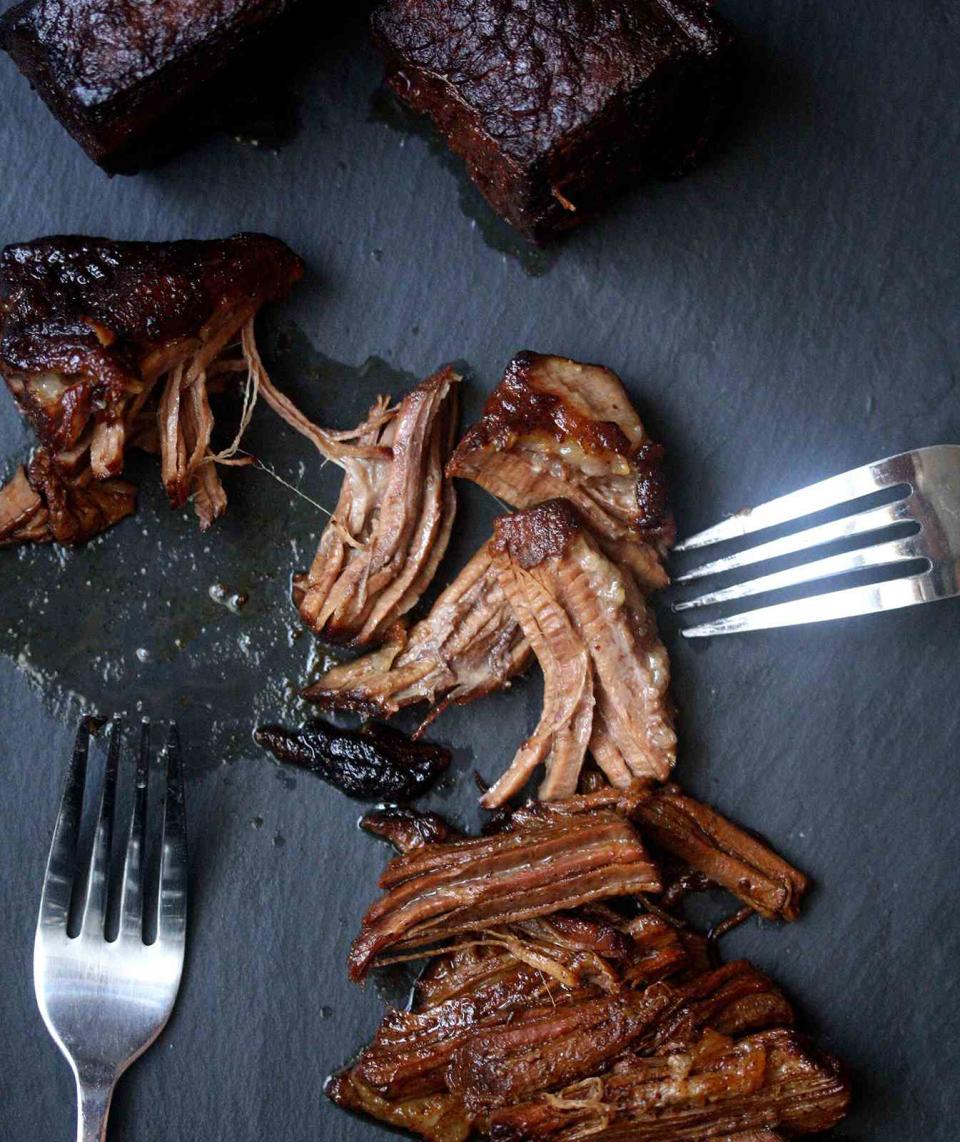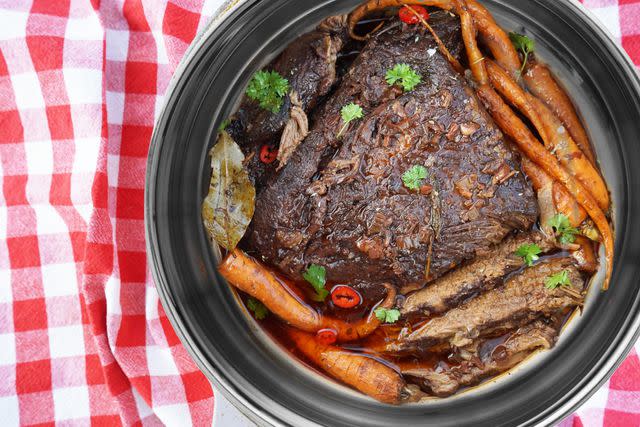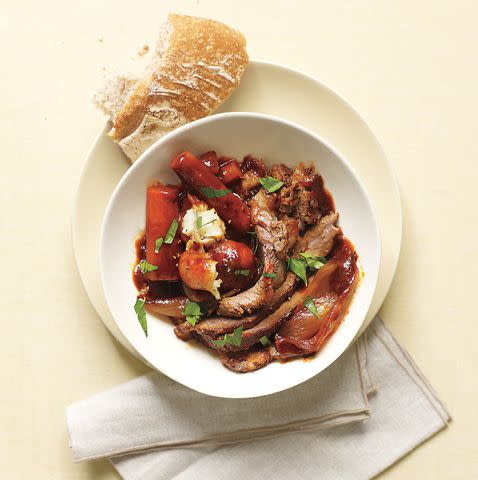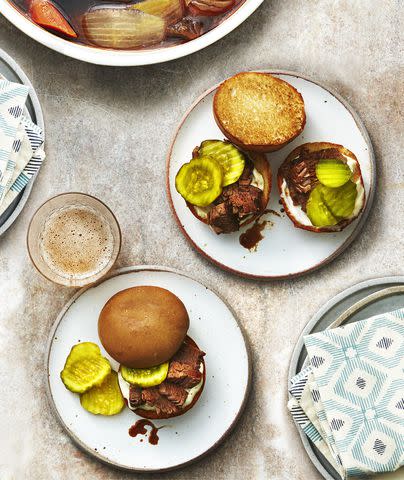9 Brisket Facts You Probably Didn't Know (But Should)
A lot more people are enjoying brisket these days. Here's what to know about this flavorful meat.

Fact checked by Haley Mades
While southeastern states tend to favor pork in their BBQ dishes, Texas-style BBQ is all about brisket. And this tough but flavorful cut of beef has exploded in popularity all over the country, popping up on restaurant menus from coast to coast. (This is partly why this traditionally budget-friendly meat is no longer quite so affordable.)
Brisket is commonly cooked at a low temperature for a long time—until it's so moist and tender it falls right off your fork. Here, we offer the basics on this popular meat, plus some recipes so you can try it yourself.
It's a Pec Muscle
Just like a toned bodybuilder (sort of), a cow has hefty pectoral muscles. Brisket is cut from those muscles, and it generally weighs 12 to 20 pounds.
It Needs to Be Cooked For a Long Time
This means brisket has a lot of tough connective tissue. Cook it using low heat for a long time ("low and slow") to break down that tissue for ultra-tender results.
A Long Rest Is Necessary
There are many techniques for cooking brisket, but all pitmasters will agree that resting the meat is one of the most important parts of the process. You should allow the brisket to rest for a minimum of one hour, ensuring that its internal temperature is at least 160°F at the time of slicing.
Most pitmasters will also advise against letting the brisket rest for too long, as any time more than two hours will cause the meat to become dry and cold—unsalvageable even when reheated in the microwave.
It Has a Secret Deckle
Because it's so large, brisket is usually cut into two pieces. Most grocery stores carry the first cut, also called the flat. It's leaner and slices neatly. But your butcher may have the second cut, also known as the deckle point. It's marbled with fat and falls apart when you cook it.
The Cut Matters
Two familiar ways to cook brisket—smoking and braising—result in very different tastes. Smoked brisket is made with the second, fattier cut attached, so it doesn't dry out after hours in the smoker.
Braised brisket is ordinarily made from only the first cut, which helps the leaner meat hold moisture. If your braised brisket tends to be dry, try using the deckle point instead. It may fall apart when you slice it, but it'll be moist and succulent.
Fat Is a Good Thing
When it comes to brisket, fat is your friend. In fact, you'll want to keep the meat fat side up while cooking, so the juices can drip through the meat and it stays moist.
Speaking Of Fat, It May Benefit Your Health, Too
When you think of brisket, you may not necessarily consider it to be one of the healthiest sources of protein out there. This is a fair assumption, considering that it can have a high-fat content, depending on the cut of brisket you get.
However, Dr. Stephen Smith, a research scientist at Texas A&M University, is suggesting that the fat in brisket is more nutritious than most people think. He explained that ground beef made from brisket had high levels of oleic acid, which contributes to the production of HDL, or what's known as the "good cholesterol" in humans. “Brisket has higher oleic acid than the flank or plate, which are the trims typically used to produce ground beef,” he said.
Corned Beef and Pastrami Are Made From Brisket
Did you know that corned beef and pastrami are made from brisket? Corned beef is prepared by curing brisket in a brine for several days, and then boiling the meat for several hours. Similarly, pastrami is cured in brine for the same amount of time but is then seasoned with spices, smoked, and then steamed.
Brisket Has Jewish Origins
Brisket roots back to 18th-century Ashkenazi Jewish communities in Eastern and Central Europe. It was—and still is—commonly eaten on holidays like Rosh Hashanah, Passover, and Hanukkah because it is meat from the breast of the cow, making it kosher.
Brisket didn't become popular in the US until the early 20th century when tens of thousands of European Jewish people immigrated to Texas. A little over one hundred years later, hundreds of brisket recipes exist and is now a favorite dish among barbequers worldwide.
Our Favorite Brisket Recipes
Red Wine Braised Brisket

Red wine and a bit of honey provide lots of flavor in this brisket recipe. Nearly any side will complement it, but we recommend something that can soak up the gravy like wild rice, couscous, polenta, or egg noodles.
Slow-Cooker Coffee-Braised Brisket With Potatoes and Carrots

Here the brisket spends all day in a slow cooker soaking up a marinade made of Worcestershire sauce, tomato paste, coffee, and brown sugar.
Gochujang Braised Brisket

This brisket gets its spiciness from a Korean chile paste called gochujang, whose ingredients include fermented soybeans. Serve with mashed potatoes or as the filling in brisket sandwiches.
Related: 34 Mouthwatering BBQ Side Dishes for Pulled Pork, Brisket, and More
For more Real Simple news, make sure to sign up for our newsletter!
Read the original article on Real Simple.

